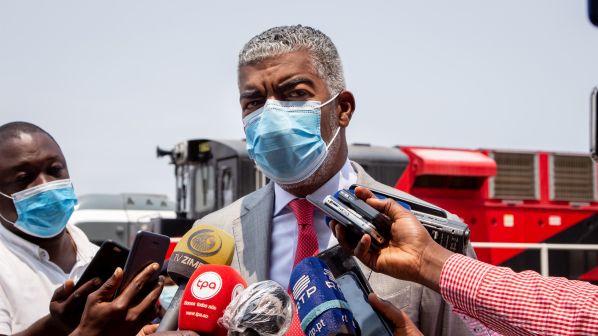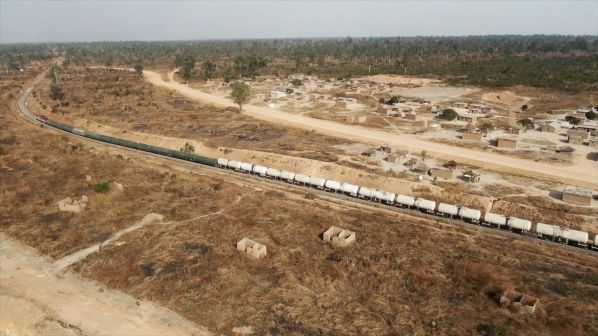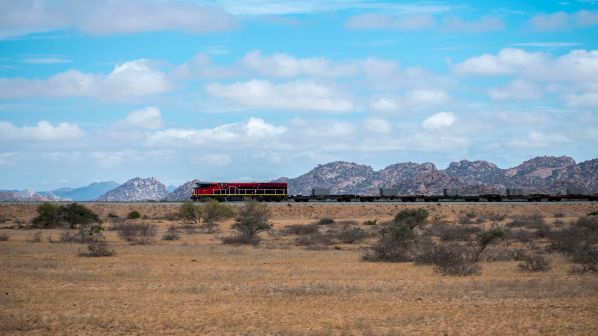LOCATED on the Atlantic coast of southwestern Africa, nestled between Namibia to the south and the Democratic Republic of Congo (DRC) to the north and east, Angola is a land of tropical beaches, rainforests and plains, and rapidly expanding cities. The country possesses sub-Saharan Africa’s third largest economy, and since the conclusion of a 27-year civil war in 2002 and the related humanitarian crisis, successive governments have sought to modernise the country and improve the standard of living for its more than 32 million inhabitants.
Angola’s extensive oil reserves are the foundation of the post-war economic recovery. The country has improved its standing from the bottom of many of the world’s measures of economic performance and prosperity in the past 20 years. However, like much of sub-Saharan Africa, transport infrastructure is a major Achille’s heel. 27 years of war left roads and the three operational 1067mm-gauge railways in poor condition. The population also continues to bear the risk posed by thousands of land mines littered across the countryside, the enduring legacy of a brutal conflict.
In the years following the civil war the government prioritised using its oil revenue to improve infrastructure. For rail, rehabilitation of the 1344km Benguela Railway on the Lobito corridor, which stretches from the Atlantic port of Lobito to the border with the DRC at Dilolo, was a key element of these plans.
The government invested $US 3.2bn in revitalising the port and railway infrastructure between 2007 and 2010. It also benefitted from Chinese support, with work to restore the connection completed in August 2014. Cross-border services were subsequently reintroduced between Angola and the DRC in March 2018, when a 25-wagon train carrying 1000 tonnes of manganese crossed into Angola, bound for export to India and China.
The reopening of the railway was a major achievement. However, it is one of the few bright spots in the first 15 years or so after independence. A report published in 2018 by the think tank Chatham House, Britain’s Royal Institute of International Affairs, says the country failed to use its oil revenue effectively, extracting limited value for money for the infrastructure projects it did undertake.
Mr João Lourenço was elected Angola’s president in 2017 under a promise to diversify the economy away from oil, increase foreign and domestic investment, and oversee private-sector development, a move that was praised by the International Monetary Fund (IMF) at the time. He succeeded Mr José Eduardo dos Santos, a fellow member of the People’s Movement for the Liberation of Angola (MPLA), who ruled the country for 38 years, and whose administration was criticised in the Chatham House report for lax management of resources and allowing corruption to go unchecked.
Dos Santos’ administration did set the framework for change and Lourenço’s government has largely kept its word. It has enacted sweeping legal reforms and an extensive privatisation programme, including for the Lobito corridor, while trying to rid the country of corruption.

While the reforms are encouraging, they have yet to transfer to definitive improvements in economic performance. The relatively low oil price compared with a decade ago, which was compounded during the Covid-19 crisis, means that Angola endured a five-year recession and 10% contraction in the national economy between 2016 and 2020, reporting the first signs of recovery in 2021. Debts of more than $US 20bn to China - the largest for any single African country - are also proving burdensome. Investors are though confident that the country is on the right course in the long term. Diversification, they say, cannot happen overnight.
A major test comes on August 24 when Angolans will go to the polls to elect a new government. Mr Ricardo Vegas D’Abreu, the country’s minister of transport, who was speaking to IRJ, is hopeful the MPLA will secure another five-year mandate. “There is a lot we still want to achieve,” D’Abreu says.
Transport plan
The guiding light for the Lourenço administration’s plans for transport infrastructure development is the National Transport Plan, issued in 2020. The document outlines priorities for investment for the next 20 years, including in the Lobito corridor as well as the country’s two other railways, which are not as well developed: the North corridor that runs east-west from Luanda to Malanje with a branch to Dondo; and the southern corridor from Mamine to Menongue with a southern branch to Cassinga.
According to D’Abreu, the plan focuses on two key pillars: regional integration and facilitating trade throughout the continent by improving transport corridors and related port infrastructure; and developing the public transport infrastructure necessary to support urban growth.
Consistent with Lourenço’s approach, D’Abreu says Angola is trying to find the right mix of financing structures to support its growth ambitions, including recruiting a private concessionaire to operate and maintain the Lobito corridor. Concessions for the other railways are likely to follow.
“This is not only an important business venture for Angola, but for the entire region to improve the competitiveness of our economies.”
Ricardo Vegas D’Abreu
A tender for the Lobito corridor was launched in September 2021 and on July 19 a consortium of Swiss-based raw commodities trader Trafigura, Portuguese construction group Mota-Engil, and Belgian private railway operator Vecturis, which has extensive experience on projects across Africa including running a training centre in Lobito, was confirmed as the winner of the 30-year concession.
The consortium held off competition from a Chinese group of China International Trade and Investment Corporation (CITIC), Sinotrans and China Railway 20 Group, which was responsible for reconstruction of some sections of the line. The decision is indicative of a growing trend for African countries to turn away from China for their infrastructure needs.
Vecturis confirmed to IRJ that the consortium will now enter a phase of negotiating the $US 100m concession agreement. The terms are largely defined by the tender, and managing director, Mr Eric Peiffer, says he expects the contract will be ready to sign in September.
Under the agreement, the concessionaire will manage, operate and maintain the Lobito corridor as well as construct freight terminals in Lobito and Luau. It will also manage and expand workshops for the line along with the staff training centre in Huambo, which opened in 2017. In addition, the concessionaire has the right to use and operate the new mineral terminal in the port of Lobito. Operation of the wider port, which has been substantially upgraded, has also been put out to a 20-year concession, although the winning Chinese consortium, which includes CITIC, is reportedly yet to sign the contract. Until they do it will be managed by the state-owned Port of Lobito.
Trafigura and Mota-Engil both hold 49.5% stakes in the consortium, and Vecturis 1%, reflecting their financial contribution, according to Peiffer. He says Vecturis will receive a fee for operating the railway, the terms of which are still to be negotiated with the partners. Mota-Engil will be responsible for infrastructure maintenance as well as execution of any works on the line. Trafigura will work on commercialisation.
As well as paying $US 319.4m to the Angolan state in the first 10 years of the contract, $US 787m in the second 10 years, and $US 919m in the final 10 years, the concessionaire will invest a minimum of $US 256m in infrastructure, $US 73.4m in equipment and rolling stock, and an additional $US 4.3m in various other activities over the duration of the concession. Peiffer describes the condition of the line as “Chinese standard” and relatively vintage; for example, there is jointed rail with fish plates rather than welded rail.
While sufficient for current needs, he does expect upgrades to take place as traffic demand increases, such as welding rail in curved sections of track to improve safety, extending passing loops, and strengthening bridges in some locations.
Angola purchased 100 2.2MW C30ACi diesel locomotives from GE (now Wabtec) in 2015 and 25 of these will be available to the concessionaire. However, Peiffer says the wagon fleet is limited and he expects the consortium to place an order for new rolling stock relatively quickly.
Mineral traffic
Under the contract, the concessionaire is required to transport 1677 million tonnes of freight per year by the fifth year of the concession. This will rise to 2982.31 million tonnes by year 10, while static figures of 4979.23 million tonnes are provided for years 20 and 30 of the agreement. The tender states that the winning concessionaire will be responsible for mineral traffic from DRC’s Copper Belt, and the transport of fuel and other freight from Lobito to destinations along the line.
While these figures are fairly low, Peiffer says they reflect the fact that the line is currently moving a great deal of relatively pure copper rather than ore. The potential for growth is significant, however, particularly for cross-border traffic with Peiffer stating that 80% of the line’s commercial potential resides in the DRC.

to the concessionaire. However, it will need to purchase wagons.
Trafigura is one of the key players in the DRC Copper Belt, the world’s fourth-largest deposit, and is likely to reserve a good proportion of the train paths. But it won’t be a closed shop. Peiffer says use of the railway will be open to Trafigura’s competitors under the same conditions. “We are not there to control access to the resources,” Peiffer says. “It is just an investment in a logistics chain and we have to be as profitable as we can.”
Manganese is the sole ore currently transported on the railway. Volumes are a fraction of what they were before 1975 and Peiffer says more work is required to understand the true potential of this traffic as well as the transport of other commodities throughout the region: DRC’s Copper Belt also produces 70% of the world’s cobalt, an essential element for battery production. It holds 60% of the planet’s coltan while extensive lithium deposits have been discovered.
The importance of the railway corridor for Angola, DRC and Zambia is reflected in a three-party agreement under the auspices of the Southern African Development Community (SADC) that will facilitate trade between the three countries. “This is not only an important business venture for Angola, but for the entire region to improve the competitiveness of our economies,” D’Abreu says.
Peiffer says that expanding cross-border operation will require the negotiation of separate arrangements with authorities in the DRC. The concession agreement after all is solely with Angola. How future track access arrangements in the DRC will work is uncertain at this stage, but Peiffer says securing the concession provides the consortium with the authority and legitimacy to enter into commercial and operational negotiations aided by the support of the Angolan government.
“That has been part of the argument in our favour,” Peiffer says. “We have been active for years in the DRC. We know the environment, we know the railway people and the railway company, SNCC, - we were involved in its management from 2007 until 2018.”
Line to Zambia
Crucially, there is an option to extend the contract by a further 20 years should the concessionaire commit to building a 200km line from Luacano to Jimbe, Zambia. A feasibility study for this link is reportedly underway and Peiffer describes this as a potential “game changer” for the Lobito project. However, he remains cautious about if and when it might happen. “At this stage, the intentions of the Zambian authorities are unclear,” he says.
There is also a strong hope that private operation of the railway will encourage the development of domestic industry within Angola; D’Abreu says this is one of the key factors in deciding to proceed with the concession. He says the railway will continue the colonial tradition of transporting mineral wealth for export. However, he hopes improved logistics will stimulate the development of facilities within the country to process these raw materials into high-value goods.
Peiffer is particularly buoyant about the prospects for agriculture. The line passes through 35% of the country’s agrucultural land and he believes there are ample opportunities to grow crops such as coffee and tobacco with several abandoned farms close to the railway hinting at extensive activity before 1975. Studies are reportedly underway on how best to tap into this potential.
“We need to make sure that the sea leg is competitive because we have to compensate for the fact that a ship heading to the Asian market will require a few more days at sea.”
Eric Peiffer
Of course, getting the goods onto a train is one thing, but exporting them is something else. Peiffer highlights access to shipping lines at Lobito port as the main challenge to the competitiveness and ultimately the success of the Lobito corridor. He says that many shipping companies favour feeder rather than direct routes to Lobito, and developing a good working relationship with the shipping lines is an early priority for the consortium.
“We need to make sure that the sea leg is competitive because we have to compensate for the fact that a ship heading to the Asian market will require a few more days at sea compared with an eastern port,” Peiffer says. “When we have been considering the opportunities, we always identified the cost of going from mine to Shanghai to determine what is the break-even point for us.”
As for when operation will start, Peiffer expects a six-month transition phase from when the contract is signed. He says this time will be invaluable given the scale of the job ahead. After all, Vecturis is effectively building up a railway operation from scratch. Major tasks ahead include incorporating the company, establishing safety rules and procedures, and recruiting and training around 1000 staff. “We are busy working on the manuals that we will use for training, adapted from the Angolan regulations, which are probably the most detailed I have seen in Africa,” Peiffer says.
Peiffer expects to require a team of at least 15 people on the ground to lead this work. He says many of these will have past experience of working on projects in Africa with Vecturis, and a critical part of their work will be transferring know-how.
“The key element for us is of course a good level of competency but also a good attitude, and sharing the same values,” Peiffer says. “A railway is a human adventure and we need to have people with experience of this kind of challenge, even if they don’t speak Portuguese, which will be a big challenge for them. For us it is important to have the right culture. Not everyone can be an expatriate working on a railway project. It is a delicate exercise both to add value and also to be followed, to be accepted, but never assimilated.”
Vecturis will be responsible for maintaining locomotives and rolling stock and will expand the existing workshops to meet this need. The workshops will also be used by Benguela Railway (CFB) staff to maintain rolling stock for passenger services, which CFB will continue to operate on the corridor. Peiffer says he is unsure of CFB’s level of traffic, which will be determined during concession negotiations.
The consortium has come a long way to reach this stage, and Peiffer admits he did not expect the bid to get as far as it did when competing with the Chinese “in an environment where they have never lost.”
Arguably, the really hard work is only now getting started. But the rewards for success are substantial. Indeed, Peiffer says the contract has the potential to transform his business. While Vecturis has been active across Africa for nearly 30 years, he admits it has flown largely under the radar. However, he expects the spotlight to now be firmly on the company. “We will have to elevate our level,” he says. “The intensity of this, especially in the first five years, will be massive. For us, it’s a game changer.”
It is also potentially transformative for Angola and a wider region desperate for economic growth and development. The Lobito corridor is primed to be a key tool in the march to economic reform.
“We believe that the infrastructure will create the opportunity,” Peiffer says. “Many investors will now see the chance to exploit those resources, which is not difficult to do. The logistics has been the main issue… but now everything is in place.”

